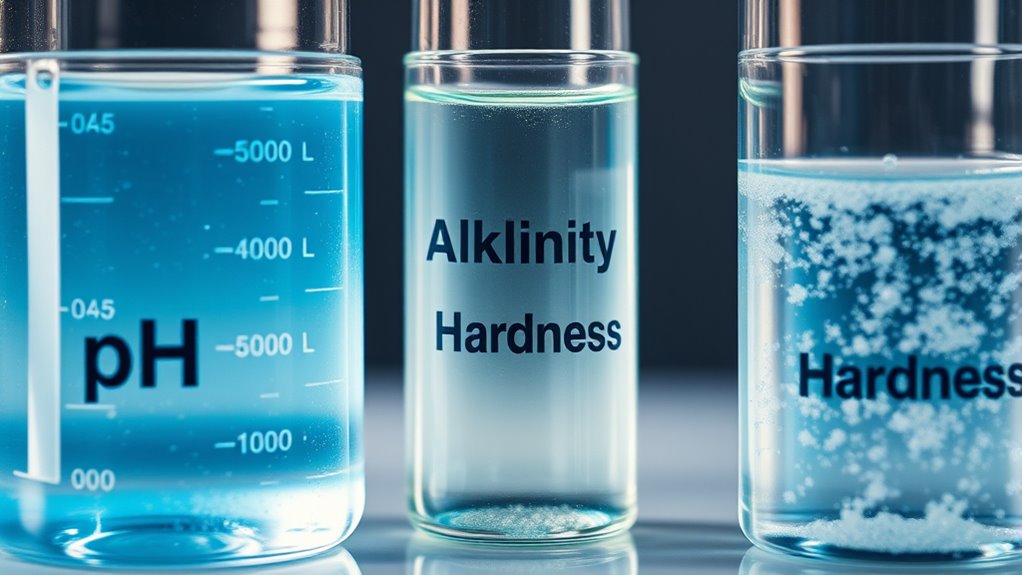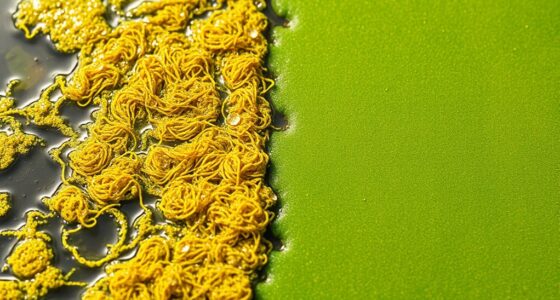Balancing pH, alkalinity, and hardness is essential to keep your water stable, safe, and clear. pH measures acidity or alkalinity, while alkalinity buffers against pH swings, and hardness indicates mineral levels like calcium and magnesium. If these elements aren’t balanced, your water can become corrosive, develop scale, or look cloudy. Understanding how they interact helps you maintain healthy, high-quality water—exploring further reveals proven strategies to keep everything in perfect harmony.
Key Takeaways
- pH indicates water acidity or alkalinity; maintaining proper levels prevents corrosion and scale buildup.
- Alkalinity buffers pH fluctuations, ensuring stable water chemistry essential for aquatic health and equipment longevity.
- Hardness, caused by calcium and magnesium, affects water taste, scale formation, and appliance performance.
- Balancing pH, alkalinity, and hardness prevents common issues like corrosion, cloudiness, and mineral deposits.
- Regular testing and cautious chemical adjustments are vital for maintaining a healthy, stable water environment.
Understanding Ph: the Measure of Acidity and Alkalinity
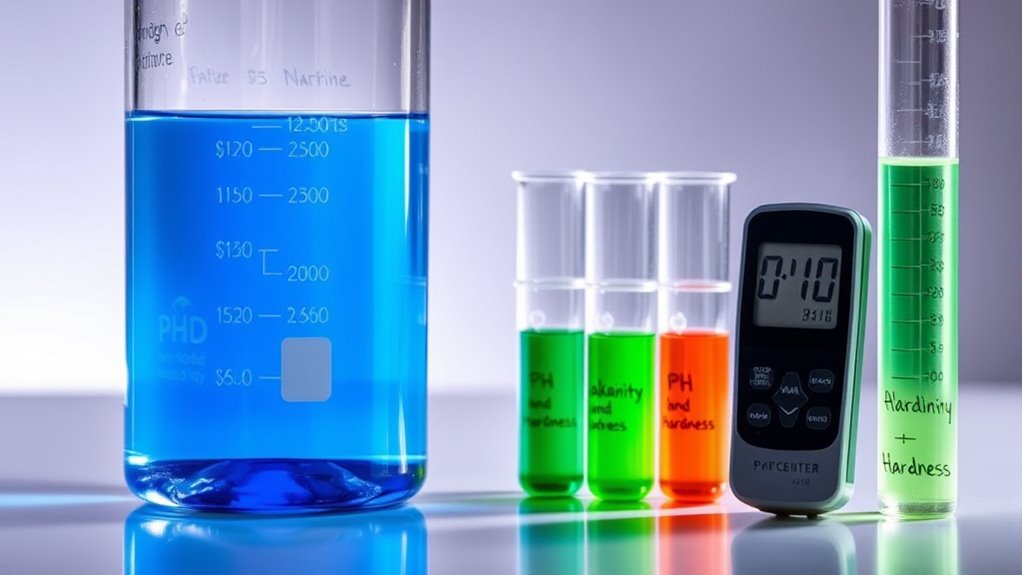
Understanding pH is essential because it tells you how acidic or alkaline a solution is. The pH scale ranges from 0 to 14, with 7 being neutral. Values below 7 indicate acidity, while those above 7 show alkalinity. You can measure pH using test strips, digital meters, or chemical indicators. Knowing the pH helps you determine the water’s suitability for various uses, like swimming pools, aquariums, or drinking water. Acidic water (low pH) can cause corrosion and skin irritation, while alkaline water (high pH) might lead to scale buildup and affect taste. Monitoring pH regularly allows you to make adjustments, ensuring water remains balanced and safe. Understanding pH helps you maintain the proper environment for your water systems and its inhabitants. Regular testing of pH levels is recommended to ensure water quality and prevent potential issues.
The Role of Alkalinity in Water Stability
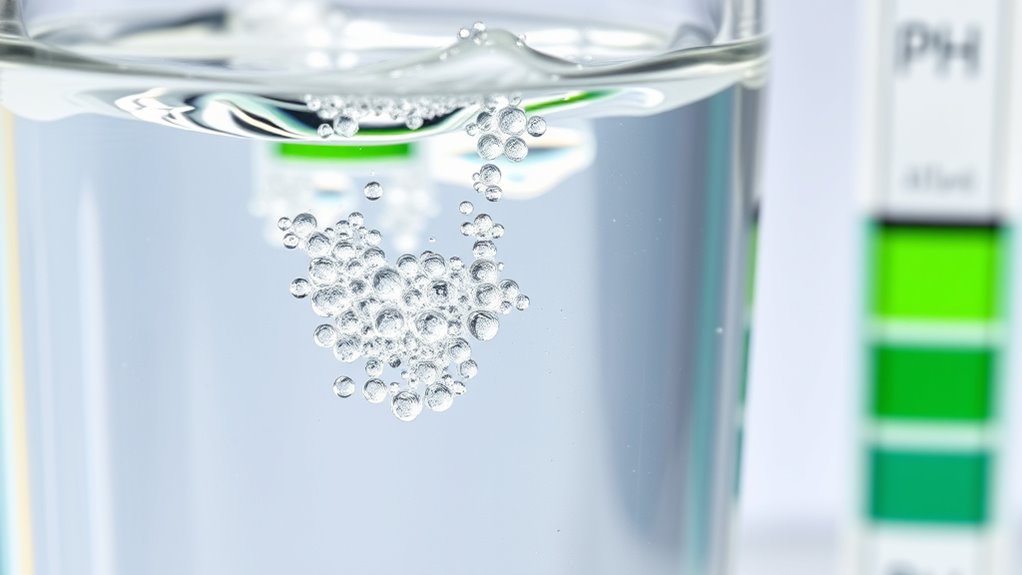
Alkalinity helps keep your water stable by buffering against sudden pH changes, preventing harmful fluctuations. It plays a key role in maintaining overall water balance, which is essential for healthy aquatic environments. Additionally, alkalinity directly impacts water quality, influencing clarity and safety. Understanding water chemistry is vital for ensuring that your water remains safe and balanced over time.
Buffering Against Ph Changes
When the pH of water is challenged by acids or bases, alkalinity acts as a buffer to maintain stability. It neutralizes added acids or bases, preventing sharp pH swings that could harm aquatic life or compromise water quality. Alkalinity primarily comes from substances like bicarbonates, carbonates, and hydroxides that can react with hydrogen ions or hydroxide ions. These reactions absorb excess acidity or alkalinity, keeping the pH within a safe, stable range. Without sufficient alkalinity, even minor changes in water chemistry can lead to rapid pH fluctuations, making water unsafe or unsuitable for its intended use. Additionally, hardness influences the buffering capacity of water, working in tandem with alkalinity to stabilize pH levels. By maintaining this buffer capacity, alkalinity helps you keep the water’s pH consistent, ensuring a healthier environment and more predictable water chemistry.
Maintaining Water Balance
Maintaining water balance is essential for ensuring a stable aquatic environment, and alkalinity plays a key role in this process. It acts as a buffer, resisting pH fluctuations that can harm aquatic life. When alkalinity is properly balanced, it helps maintain consistent conditions, reducing stress on your aquatic ecosystem. To ensure proper water balance, consider these key points:
- Regularly test alkalinity levels to keep them within the recommended range.
- Adjust alkalinity using additives like baking soda if levels fall too low.
- Monitor other water parameters, such as pH and hardness, to support overall stability.
- Avoid sudden changes in water chemistry, which can disrupt the balance and harm your aquatic life.
- Proper calibration of testing equipment and understanding projector contrast ratios can further enhance your ability to maintain optimal water conditions.
Consistent management of alkalinity keeps your water stable and healthy.
Impact on Water Quality
Proper alkalinity levels are crucial for maintaining overall water quality because they help buffer pH changes that could otherwise destabilize your aquatic environment. When alkalinity is balanced, your water resists sudden pH swings, protecting aquatic life and ensuring stable conditions. Low alkalinity can lead to rapid pH drops, stressing fish and plants; high alkalinity may cause pH to drift upward, creating an unstable habitat. To better understand, consider this table:
| Alkalinity Level | Effect on Water | Resulting Stability |
|---|---|---|
| Low | Unbuffered pH drops | Unstable water |
| Optimal | Resists pH swings | Stable environment |
| High | Excess buffering | Potential pH rise |
| Very Low | Sudden pH drops | Harmful for aquatic life |
| Very High | PH drifts upward | Stressful conditions |
Maintaining proper alkalinity ensures your water remains balanced and healthy for your aquatic ecosystem.
Hardness: The Mineral Content of Your Water

Hardness measures the mineral content in your water, mainly calcium and magnesium. These minerals affect water quality, influencing taste, cleaning efficiency, and plumbing. Understanding their levels helps you manage water use and prevent potential issues. Monitoring water composition and levels is essential for maintaining a balanced and healthy water system.
Mineral Types and Effects
Mineral types in your water directly influence its hardness, primarily through the presence of dissolved calcium and magnesium. These minerals enter your water from natural sources like rocks and soil, affecting how hard or soft your water feels. Calcium carbonate is the most common mineral contributing to hardness, but magnesium compounds also play a significant role. Hard water can cause scale buildup, reduce soap effectiveness, and damage appliances. Understanding the mineral content helps you manage water quality better. Here are key mineral types and their effects:
- Calcium Carbonate – Main contributor to hardness, causes scaling.
- Magnesium Sulfate – Adds to hardness, affects taste.
- Calcium Sulfate – Contributes to scale formation.
- Magnesium Chloride – Influences mineral content and water softness.
Hardness levels can be measured to determine the extent of mineral content in your water.
Impact on Water Quality
The mineral content in your water considerably impacts its overall quality and usability. Hard water, rich in calcium and magnesium, can cause scale buildup in pipes and appliances, reducing efficiency and lifespan. It may also make soaps less effective, leading to tougher laundry and skin issues. Conversely, soft water, with low mineral content, minimizes these problems but can be corrosive, potentially leaching metals from pipes. Drinking water with high mineral levels might taste metallic or bitter and could pose health risks if mineral concentrations are excessive. Maintaining balanced mineral levels guarantees water is safe, tastes good, and protects your plumbing and appliances. Understanding the mineral content helps you address issues proactively, choose appropriate water treatment methods, and ensure your water quality supports your daily needs. Additionally, monitoring water hardness can help prevent damage to your appliances and improve water taste.
How Ph, Alkalinity, and Hardness Interact
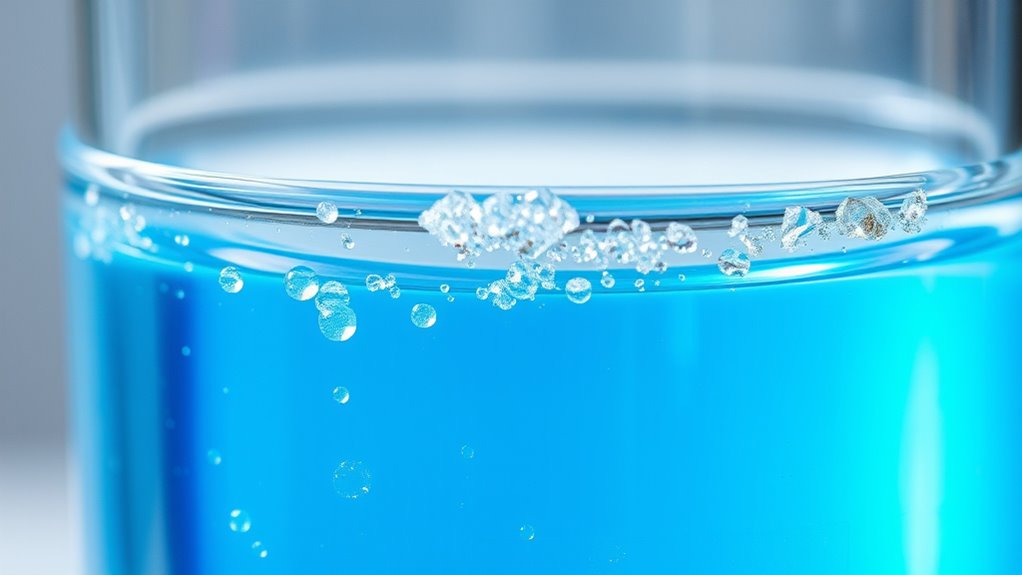
Understanding how pH, alkalinity, and hardness interact is essential for maintaining water quality. These factors influence each other, shaping the water’s stability and health. When alkalinity is high, it buffers pH changes, keeping water stable. Hardness, caused by dissolved minerals like calcium and magnesium, can affect both pH and alkalinity, either raising or lowering them depending on concentrations. For example, increased hardness can lead to higher pH levels, while low alkalinity makes water more susceptible to pH swings. Managing these interactions helps prevent issues like corrosion or scale buildup. Additionally, the presence of headphones can be affected by water quality in certain environments, emphasizing the importance of balanced water chemistry. Here’s a quick overview: 1. High alkalinity stabilizes pH. 2. Hardness influences pH and alkalinity. 3. Low alkalinity causes pH fluctuations. 4. Balancing these ensures water stability.
Effects of Imbalance in Ph, Alkalinity, and Hardness
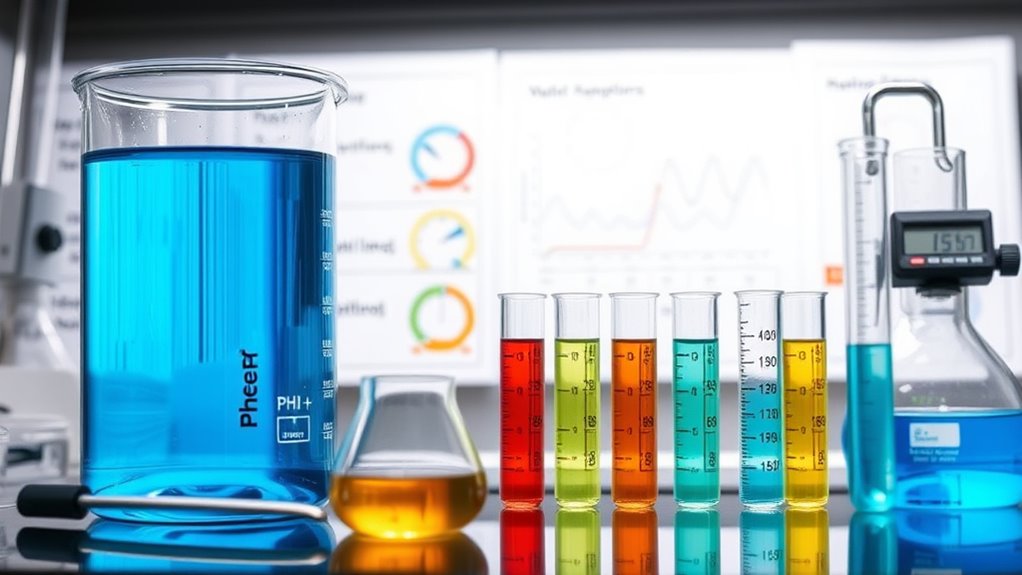
Imbalances in pH, alkalinity, and hardness can lead to significant water quality issues. When these levels aren’t properly balanced, you might notice problems like corrosion, scale buildup, or cloudy water. Sudden shifts can stress aquatic life and damage equipment. For example, too low pH causes metal corrosion, while too high pH leads to scaling. Hardness imbalances can cause mineral deposits or water that’s too soft. Here’s a quick overview:
| Issue | Effect | Cause |
|---|---|---|
| Low pH | Corrosion, metal leaching | Acidic conditions |
| High pH | Scale formation, cloudiness | Alkaline imbalance |
| Hard Water | Scale buildup, soap scum | Excess calcium/magnesium |
| Soft Water | Corrosion, skin irritation | Insufficient minerals |
Maintaining water chemistry balance is essential to prevent damage and ensure healthy water quality.
Strategies for Maintaining Balanced Water Chemistry
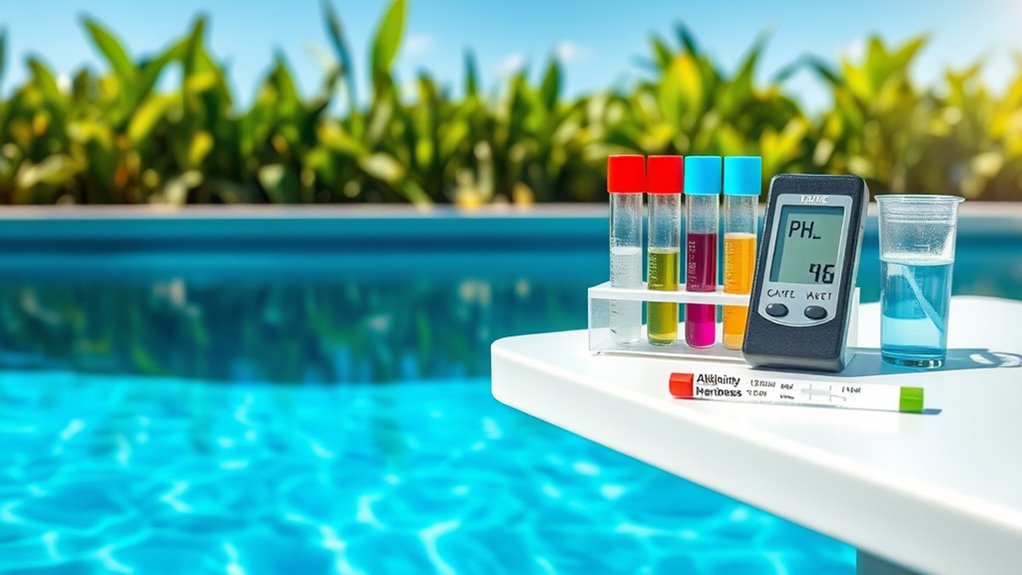
Maintaining balanced water chemistry requires proactive strategies to monitor and adjust pH, alkalinity, and hardness levels regularly. Consistent testing ensures you catch fluctuations early. Use reliable test kits or digital meters for accuracy. Add chemicals cautiously—such as pH adjusters, alkalinity increasers, or hardness stabilizers—based on test results. Keep detailed records of your measurements and adjustments to identify patterns. Regularly clean and inspect equipment to prevent buildup or contamination that could affect water quality. Also, consider using buffers to stabilize pH and alkalinity. Finally, perform partial water changes when necessary to dilute imbalances. This ongoing vigilance helps maintain a stable environment, reducing stress on aquatic life and guaranteeing ideal water conditions. Fostering mutual respect and understanding is essential for successful water chemistry management.
Frequently Asked Questions
How Do Temperature Changes Affect Water Ph Levels?
Temperature changes can cause pH levels to fluctuate because warmer water tends to lower pH, making it more acidic, while cooler water raises it, making it more alkaline. When water heats up, carbon dioxide escapes, increasing pH. Conversely, cooling water traps CO2, lowering pH. You should monitor temperature regularly, especially in aquariums or pools, because these shifts can impact aquatic life and water chemistry stability.
Can Altering Alkalinity Impact Water Treatment Processes?
Think of alkalinity as the shield in your water treatment battle; when you alter it, you directly influence how effectively your processes work. Increasing alkalinity can stabilize pH, preventing sudden shifts that hinder filtration or disinfection. Conversely, lowering it might make water more vulnerable to pH swings, complicating treatment. So, adjusting alkalinity isn’t just a tweak—it’s a strategic move that shapes your entire treatment outcome.
What Are the Health Implications of High Water Hardness?
When water hardness is high, you might notice soap doesn’t lather well and mineral deposits build up in pipes and appliances. Consuming very hard water can lead to kidney stones in some people, especially if you have a history of them. While it’s generally safe to drink, hard water may affect your skin and hair, causing dryness or irritation. If hardness levels are extreme, consider using a water softener to improve quality.
How Do Ph, Alkalinity, and Hardness Influence Aquatic Life?
You impact aquatic life by understanding how pH, alkalinity, and hardness influence their environment. Stable pH levels prevent stress and health issues in fish and plants, while proper alkalinity buffers against sudden pH changes. Hardness provides essential minerals that support biological functions. By maintaining balanced levels, you create a healthier ecosystem, promoting thriving aquatic organisms and preventing harmful conditions that could lead to stress, disease, or death.
Are There Natural Methods to Adjust Water Chemistry Balance?
Remember, “Nature knows best.” You can naturally adjust water chemistry by adding crushed coral to raise pH and hardness or using peat moss to lower pH and soften water. Regularly testing your water helps you make informed decisions. Swapping out water during partial changes also balances chemicals gently. These natural methods support healthy aquatic environments without harsh chemicals, aligning with nature’s own balancing act.
Conclusion
Balancing pH, alkalinity, and hardness is vital for healthy water. Think of it like a delicate dance—you need the right steps to keep everything stable. Some say that if one element falls out of sync, it can throw off the entire system. While science supports the importance of balance, many believe nature has a way of self-correcting over time. Staying vigilant helps you maintain water quality and protect your aquatic environment.
